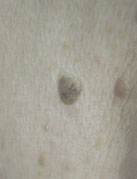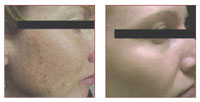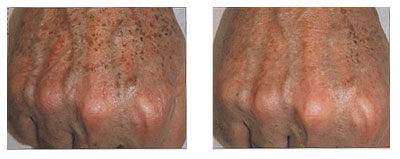General Dermatology
Acne Treatments - Acrochordons - Eczema Treatment - Lentigo - Moles - Psoriasis Treatment - Rosacea Treatment - Seborrhea
Seborrheic Keratoses Treatments - Sun Damage - Skin Cancer Screening - Warts
Seborrheic Keratoses Treatments
 Seborrheic keratoses are non-cancerous growths of the outer skin layers and are often confused with warts. They can vary in size (growing as large as half dollar) and color (from light tan to black). Characteristic features include a waxy or "stuck-on" appearance. The cause of Seborrheic keratoses is unknown, but they are hereditary, increase in numbers and size with age, and are non-contagious. The growths are most commonly found on the chest or back, but can be found anywhere in the body. Over time, these growths may turn black, making it difficult to clinically distinguish from skin cancer and may require a biopsy. Removal may be recommended if they become large, irritated, itch or bleed easily. Therapies include liquid nitrogen freezing, electrical cauterization or excision.
Seborrheic keratoses are non-cancerous growths of the outer skin layers and are often confused with warts. They can vary in size (growing as large as half dollar) and color (from light tan to black). Characteristic features include a waxy or "stuck-on" appearance. The cause of Seborrheic keratoses is unknown, but they are hereditary, increase in numbers and size with age, and are non-contagious. The growths are most commonly found on the chest or back, but can be found anywhere in the body. Over time, these growths may turn black, making it difficult to clinically distinguish from skin cancer and may require a biopsy. Removal may be recommended if they become large, irritated, itch or bleed easily. Therapies include liquid nitrogen freezing, electrical cauterization or excision.
Schedule a Consultation Today
Sun Damage

*Photorejuvenation treatment
Adequate protection from the sun and avoidance of other sources of ultraviolet light, such as tanning salons, are an important part of preventing skin damage. Protection from the sun can begin with adequate clothing, avoiding peak hours (10am to 4pm), wide-brimmed hats, sunglasses and sunscreen with a high SPF rating that is broad spectrum to block out both UVA and UVB light. There are ways to cosmetically improve damage that is already present. Injectable fillers such as Restylane®, collagen and Hylaform fill out lines and wrinkles to give the skin a fuller, smoother look and feel. Photofacials can reduce the appearance of uneven pigmentation, dilated blood vessels, other vascular lesions, and reduce the signs of aging by using non-invasive, painless pulses of light. Photofacial treatments can also improve the appearance of vascular birthmarks, uneven pigmentation and stimulate the production of collagen with no recovery time required and a low risk of complications. Multiple sessions of about 20 minutes each are performed every few weeks until the desired result has been achieved. Chemical peels and microdermabrasion remove the surface layer of skin to expose a fresh, healthier, younger-looking layer beneath. Vbeam Laser treatments may also be effective for facial wrinkles, dilated blood vessels, scarring and stretch marks.
Age Spot Before & After

Age spot treated with Palomar LuxG™
Skin Cancer Screening
Skin cancer is mainly caused by ultraviolet (UV) radiation from the sun, but other sources of UV radiation such as sunlamps and tanning booths may also be a cause. Basal cell carcinoma, Squamous cell carcinoma and Melanoma are three main subtypes of skin cancer, and they each vary in their appearance and ability to spread to other parts of the body.
The most common type of skin cancer is Basal cell carcinomas; this type of skin cancer is slow growing, rarely spreads to other parts of the body, and is most commonly found on the face, scalp, ears, chest, back and legs. The following are the most typical features of basal cell carcinomas:
- A shiny bump that is pearly or translucent; blood vessels may be seen on the surface
- An open sore that bleeds, heals up and recurs again
- A scar like area that is white, yellow or waxy and has poorly defined edges
A board certified dermatologist should evaluate any skin condition with the above-mentioned characteristics immediately.
Squamous cell carcinomas (SCC) can be found anywhere on the skin and has the ability to spread to other areas of the body. SCC can arise from a pre-cancerous lesion called an actinic or solar keratosis. Actinic keratosis can appear as rough and scaly patches with a red or inflamed base and can progress to SCC. Just as with Basal cell carcinoma, lesions with similar characteristics mentioned for SCC should be evaluated by a board certified dermatologist immediately.
Melanoma is the most serious form of skin cancer. Melanomas can occur anywhere on the body, but is most commonly found on the back and legs and has the highest skin cancer potential to spread to other parts of the body. For characteristics of melanoma, please read under moles & birthmarks.
Appropriate diagnosis begins with detection by a board certified dermatologist followed by a skin biopsy. For any skin cancer, treatment can involve both medical and surgical procedures depending on the type of cancer, location, if it has spread to other areas of the body and the individual. Therapeutics includes excisional surgery, Mohs micrographic surgery, radiation, photodynamic therapy, and chemotherapy.
Warts
Warts are non-cancerous skin growths caused by the Human papillomavirus and can be indirectly passed from person to person. Different warts respond to different treatments. Therapeutics for warts ranges from topical solutions such as Salicylic acid and Cantharidin to electrical cauterization and liquid nitrogen freezing. For adults and older children, freezing is generally preferred, which is not too painful and rarely causes scarring. For larger and resistant warts, repeat treatments are often necessary.



